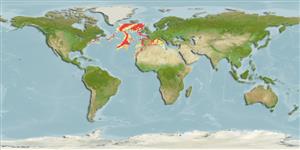>
Gadiformes (Cods) >
Macrouridae (Grenadiers or rattails)
Etymology: Coryphaenoides: Greek, koryphaina = dolphin fish + Suffix oides = similar to (Ref. 45335).
More on author: Vaillant.
Environment: milieu / climate zone / depth range / distribution range
Ökologie
seewasser bathydemersal; standorttreu; tiefenbereich 831 - 2830 m (Ref. 1371). Deep-water; 62°N - 19°N, 74°W - 17°E
Atlantic Ocean: Faroe-Shetland Channel to the Canary Islands, Iceland, Denmark Strait, Nunavut (Ref. 58426) and the western Mediterranean (Ref. 3587, 6187).
Size / Gewicht / Alter
Maturity: Lm ? range ? - ? cm
Max length : 50.0 cm TL Männchen/unbestimmt; (Ref. 1371)
Kurzbeschreibung
Morphologie | Morphometrie
Rückenflossenstacheln (insgesamt): 0; Rückenflossenweichstrahlen (insgesamt): 11-12; Afterflossenstacheln 0. The head is relatively compressed; the eyes are large. The mouth is small and inferior. The scales have about 10 rows of large and broad spinules. The body is generally brownish, with the mouth and gill cavity darker.
Epibenthic (Ref. 58426). Feeds on small benthic invertebrates (annelids, isopods and mysids) (Ref. 6187).
Life cycle and mating behavior
Geschlechtsreife | Fortpflanzung | Ablaichen | Eier | Fecundity | Larven
Cohen, D.M., T. Inada, T. Iwamoto and N. Scialabba, 1990. FAO species catalogue. Vol. 10. Gadiform fishes of the world (Order Gadiformes). An annotated and illustrated catalogue of cods, hakes, grenadiers and other gadiform fishes known to date. FAO Fish. Synop. 125(10). Rome: FAO. 442 p. (Ref. 1371)
IUCN Rote Liste Status (Ref. 130435)
Bedrohung für Menschen
Harmless
Nutzung durch Menschen
Fischereien: nicht kommerziell
Mehr Information
NamenSynonymeMetabolismusRäuberÖkotoxikologieFortpflanzungGeschlechtsreifeAblaichenSpawning aggregationFecundityEierEientwicklung
ReferenzenAquakulturAquakultur ProfilZuchtlinienGenetikElectrophoresesVererbbarkeitKrankheitenVerarbeitungNutrientsMass conversion
Tools
Zusatzinformationen
Download XML
Internet Quellen
Estimates based on models
Preferred temperature (Ref.
123201): 3.6 - 7.8, mean 4.4 °C (based on 265 cells).
Phylogenetic diversity index (Ref.
82804): PD
50 = 0.5000 [Uniqueness, from 0.5 = low to 2.0 = high].
Bayesian length-weight: a=0.00219 (0.00111 - 0.00431), b=3.20 (3.03 - 3.37), in cm total length, based on LWR estimates for this (Sub)family-body shape (Ref.
93245).
Trophic level (Ref.
69278): 3.3 ±0.42 se; based on food items.
Widerstandsfähigkeit (Ref.
120179): sehr niedrig, Verdopplung der Population dauert mehr als 14 Jahre. (Preliminary K or Fecundity.).
Fishing Vulnerability (Ref.
59153): Moderate vulnerability (40 of 100).
Nutrients (Ref.
124155): Calcium = 20.8 [11.5, 51.7] mg/100g; Iron = 0.379 [0.185, 0.796] mg/100g; Protein = 16.3 [14.5, 18.0] %; Omega3 = 0.234 [0.104, 0.502] g/100g; Selenium = 27.6 [10.2, 71.0] μg/100g; VitaminA = 11 [2, 54] μg/100g; Zinc = 0.468 [0.291, 0.781] mg/100g (wet weight);
